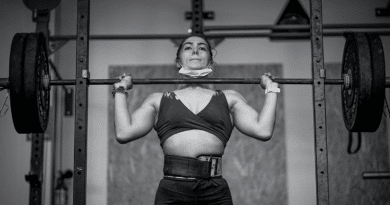Sled Pull Workouts to Burn Fat and Build Conditioning
Few exercises are as simple and effective as the sled pull.
Nearly everyone can perform them, regardless of ability level, background, and/or personal goal. They work to increase power, strength, muscle mass, and aerobic endurance, all while sizzling body fat.
Benefits of Sled Pull Workouts
Nearly Everyone Can Do Them
This is about as basic as things can get.
If someone can walk or crawl, they can do sled pulls. The ability to set this up for youth athletes, elderly, and everywhere in between makes it a very valuable training option for all goals and ability levels.
You can simply have the individual grab the straps and pull/drag the weight, or harness them up to the tethers and have them start moving.
Total Body Conditioning Workout
If you have ever done a sled pull workout, you will have no issues agreeing with me on this one. The legs, glutes, core, back, shoulders, and arms are all thrust into action during this highly demanding and metabolic workout option, regardless of speed being used or load.
Yes, you can manipulate certain variables and change variations to better highlight certain muscle groups, however the systemic stress placed upon the anaerobic and aerobic systems is felt throughout the entire system.
Increased Power, Strength, and Size
The sled pull has a muscle contract over long durations, typically at least 30 seconds (unless done for acceleration purposes, see below). When contracting and producing force, sometimes near maximal levels, if the sled is heavy, can create significant strength and size adaptations.
Durations of 60-90 seconds can work muscular endurance and hypertrophy, 30-60 seconds producing strength and hypertrophy, with sprint’s of 5-15 seconds working the anaerobic power systems.
Perfect for Recovery
Sled work is full of concentric muscle actions, meaning that the lengthen aspect of muscular contractions (called the eccentric contraction) is not present/is minimal, resulting in more oxygen rich blood being pumped into the muscle and metabolites being cleared out of a muscle.
Because eccentric muscle action has been linked with delayed onset muscle soreness (DOMS), sled training is a useful exercise to increase blood flow to muscle tissues, clear metabolites, and increase GPP (general physical preparation)
Low Chance of Injury
The simplicity and self-regulating nature of this exercise (meaning the the user defines their output) makes this a straightforward and low risk movements for all fitness levels.
As with any exercise program, if you are unsure of your readiness to participate you should seek a medical professional to have a proper health screening. Once you are set and cleared, seek out a profession, or simply start dragging moderate loads around. It’s quite basic yet offers some pretty amazing results.
Improves Acceleration
Athletes, runners, and speed-focused trainees can develop serious acceleration specific to running and sprinting with sled pulls.
Lightweight harnesses attached to an athlete can increase force output and ground reaction forces, which in turn will remain once the load is taken off.
It is important to note that the load must not be heavy, as the load should not affect the sprinting mechanics of the athlete, rather offer some very light resistance. In the world or most formal sports and sprinting based event, strong athletes are good, slow athletes are bad, and strong and explosive athletes are best!
Sled Pull Muscles Worked
Sled pulls are a brutal functional exercise that hits the upper body, developing both aerobic and anaerobic capacity and targeting the back, shoulders, biceps and grip muscles.
How to Sled Pull
Step One: Be sure to warm up the body with basic cardiovascular work such as the stair climber, jogging, or jumping jacks.
The Jacob’s Ladder is an insanely good cardio warm-up if your gym offers it. A combination of a few different cardiovascular exercises will work best. Do this for about ten to fifteen minutes and follow it up with a stretching session.
Step Two: Place an appropriate amount of weight plates onto the sled. Position yourself so that one foot is in front of the over facing towards the handles of the sled.
Step Three: Tighten your core and straighten your back as you bend at the hips, bringing yourself into alignment with the sled.
Step Four: Secure a firm grip on the handles of the sled and check your stance one more time.
Step Five: Begin by taking a step forward with the back leg, keeping your arms straight the whole time.
Step Six: Continue walking forward until you’ve reached your prescribed distance. Turn the sled around and begin again.
Bonus Step: If you are using a sled for pulling movements, be sure to brace the core and back while slightly bending the knees. Begin by grabbing over hand with the right hand following this with an overhand with the left hand. Continue this pattern until you pull the sled to yourself.
Sled Pull Tips and Tricks for Beginners
If you’re just starting out with the Sled Pull, here is some advice to keep in mind to make sure you perform the exercise correctly while staying safe.
No Need to Load Up: Sure, that giant truck might be your goal to pull, but don’t start out with one.
Begin with a light load as you perfect the form and technique and the sled drag. Gradually increase the weight plates you use week by week.
Consider Wearing Gear: While the sled drag can be a low impact exercise, it’s important to safeguard yourself if you have prior injuries involving your wrists, knees, or lower back.
Wrist wraps help to protect from strain while knee sleeves offer compression-based support. You don’t need a weightlifting belt for the sled drag, however, you may want to consider a back brace if you’ve had issues in the past.
Sled Pull Workouts
WORKOUT 1
Every 4 Minutes For 28 Minutes
- 100 yard Sprint
- 50 yard Empty Sled Push
- 50 yard Empty Sled Rope Pull
On a 28 minute clock, perform the prescribed work in the order written every 4 minutes. Athlete must complete 100-yard Sprint, 50-yard Sprint forward and 50-yard Sprint coming back to the starting position.
Then, athlete will push an empty Sled (100 lb) 50 yards and pull at back 50 yards using an attached rope to the Sled.
If completed before the 4 minute mark, rest the remainder of the time.
Find the best Barbell for you.
WORKOUT 2
EMOM for 20 minutes
- 100 foot Sled Pull
Max Rep Burpees with remaining time in each minute.
Each minute on the minute (EMOM) perform a 100-ft sled pull, then as many burpees as possible before starting the sled push again at the top of the next minute. Score is total number of burpees completed in 20 minutes.
WORKOUT 3
For Time
5 Rounds of:
- 400 metre Run
- 25 metre Sled Push
Rest 5 minutes
Directly into, 5 Rounds of:
- 400 metre Run
- 25 metre Sled Pull
Time Cap: 45 minutes
With a running clock, as fast as possible perform the prescribed work. For the first part, athlete must complete 5 rounds of 400 metre Run and 25 metre Sled Push. Rest 5 minutes. For the second part, perform 5 rounds of 400 metre Run and 25 metre Sled Pull.
Score is the time on the clock when the last round of the 25 metre Sled Pull is completed.
Tips and Strategy
The workout alternates 400m Runs with Sled work. Pick a weight for the Sled that you are able to maintain the entire workout at around 75% effort.
Try to catch your breath during the Runs so you can prepare for the next Sled Push/Pull efforts.
Scaling Option
You can scale the workout by decreasing from 5 to 3 rounds.
WORKOUT 4
4 Rounds for Time
- 1,000 metre Run
- 25 metre Sled Push
- 1,000 metre Run
- 25 metre Sled Pull
Time Cap: 80 minutes
With a running clock, as fast as possible completed the prescribed work in the order written for 4 rounds.
Score is the time on the clock when the last round of the Sled Pull is completed.
Tips and Strategy
This workout combines Running with Sled Push and Sled Pull. Pick a moderate to heavy weight for the Sleds, and make sure that the weight for Sled Push is heavier than for Sled Pull.
Key to this workout is how good you can pace the Run part. Use the first round, to find a comfortable tempo and try to maintain this for the entire 4 rounds. The time cap for Presley is 80 minutes.
Scaling Options
Decrease the time cap from 80 to 40 minutes, along with lighter weights for Sled Push and Pull.
WORKOUT 5 – “BERRY”
10 Rounds for Time (with a Partner)
- 300 metre Ski Erg
- 20 Wall Ball Shots (20/14 lb)
- 25 metre Sled Pulls
Time Cap: 60 minutes
This is a Hyrox Doubles Workout, that you should complete in a 2-person-team.
One round consists of 300 metre Ski Erg, 20 Wall Ball Shots, and 25 metre Sled Pull. DOUBLES-Team-Member 1 (DTM) completes one entire round, then DTM2 completes another entire round.
Continue this until you completed 10 rounds total. The time cap for BERRY is 60 minutes.
Score is the time on the clock when the last round of the Sled Pull is completed.
Scaling Options
Reduce reps and distances by half.
WORKOUT 6
For Time
- 50 Shoulder-to-Overheads (115/75 lb)
- 50 foot Arm Over Arm Sled Pull
- 40 Burpees
- 50 foot Arm Over Arm Sled Pull
- 30 Sumo Deadlift High Pulls (85/55 lb)
- 50 foot Arm Over Arm Sled Pull
With a running clock, as fast as possible perform the prescribed work in the order written. For the Sled Pull, use a load that is challenging but doesn’t require extended rest periods.
Score is the time on the clock when the last set of the Sled Pull is completed.
WORKOUT 7
4 Rounds for Time
- 400 metre Row
- 12 Weighted Alternating Lunges
- 25 metre Sled Push
- 25 metre Sled Pull
Time Cap: 25 minutes
With a running clock, as fast as possible perform the prescribed work in the order written for 4 rounds.
Score is the time on the clock when the last round of the Sled Pull is completed.
Intended Stimulus
Challenge yourself by using a heavy or the competition weight for the Sleds. Same goes for the Weighted Alternating Lunges. The crucial factor here is the combination of Sled Push and Sled Pull.
Scaling Options
Scale Stone by doing bodyweight Lunges and decreasing the weights of the Sleds.
WORKOUT 8
- 3 Rounds for Time
- 1000 metre Row
- 21 Push-Ups
- 100 metre Sled Drag
- 15 L Pull-Ups
- 100 metre Sled Drag
- 9 Kettlebell Swings (1.5 pood)
- 1 Rope Climb
WORKOUT 9 (PARTNER)
AMRAP (with a Partner) in 40 minutes
- 800 metre Medicine Ball Run (20/14 lb)
- 100 Kettlebell Swings (53/35 lb)
- 10 Tire Flips and Jump Thru (As Heavy As Possible)
- 4 200 metre Fire Hose Drag and Pull (50 ft)
- 100 Alternating Kettlebell Cleans (53/35 lb)
- 50 Push-Ups
- 50 Step Walking Lunges
This is a partner WOD. Run the 800M together sharing the med ball carry. Then complete the other movements in any rep or set scheme in a “you go. I go.” pattern with one partner working while the other rests.
Continue until 40 minutes have elapsed.
For the “tire flip and jump thru,” Partner 1 will flip the tire then jump into and out of the center landing on the opposite side completing the first rep. Partner 2 will then take their turn.
Partners alternate until 10 reps are completed for the round. If the tire is too heavy for one partner, both may work together to flip the tire and take turns jumping through.
“Fire Hose Drag and Pull,” Partner 1 starts the 200M by grabbing one end of the hose and running until the hose is fully extended.
Then Partner 1 turns and faces the starting point and pulls the hose to them until the total length of the hose has been gathered up in a pile between their feet.
Partner 2 then grabs the end of the hose and does the same making forward progress toward the 200M mark. Partners continue taking turns until all 200M has been completed.
If a fire hose is not available, use a battle rope of similar length.
Scaling
Intermediate
AMRAP (with a Partner) in 40 minutes
- 800 metre Run
- 100 Kettlebell Swings (35/25 lb)
- 10 Tire Flips and Jump Thru (As Heavy As Possible)
- 4 200 metre Fire Hose Drag and Pull (50 ft)
- 100 Alternating Kettlebell Cleans (35/25 lb)
- 30 Push-Ups
- 30 Step Lunges
Beginner
AMRAP (with a Partner) in 40 minutes
- 400 metre Run
- 50 Kettlebell Swings (35/25 lb)
- 5 Tire Flips and Jump Thru (As Heavy As Possible)
- 2 200 metre Fire Hose Drag and Pull (50 ft)
- 50 Alternating Kettlebell Cleans (35/25 lb)
- 20 Push-Ups
- 20 Step Lunges
WORKOUT 10
15 Rounds for Total Reps
5 Rounds of:
- 25 metre Sled Push
- 90 second Rest
Then, 5 Rounds of:
- 25 metre Sled Pull
- 90 second Rest
Finally, 5 Rounds of:
- 1 minute Wall Ball Shots (20/14 lb)
- 30 second Rest
1 minute Burpee Broad Jumps
- 30 second Rest
- 1 minute Row for Calories
30 second Rest
- 1 minute 10 metre Shuttle Runs
- 30 second Rest
This workout consists of 3 parts to be completed one after another.
Pick a heavy but doable weight for the Sled Pull and Sled Push, and rest 90 seconds after each 25m effort. The last part consists of 4x 1 minute of work, followed by 30 seconds of rest for a total of 5 rounds.
There will be three scores for this workout.
Score A is the time to complete the 5 rounds of 25 metre Sled Push.
Score B is the time to complete the 5 rounds of 25 metre Sled Pull.
Score C is the total number of repetitions completed in the last 5 rounds. 1 calorie = 1 rep, 1x10m run = 1 rep
Scaling Options
You can scale the workout by decreasing all rounds from 5 to 3 for all parts, and increase the rest to 1 Minute for the last part.
WORKOUT 11 (PARTNER)
Buddy amrap 15 min
- 15 wallball shots 20/14
- 20m reverse sled drag *while buddy sits on the sled*
*4 plates of 45 lbs on the sled for men and for women 3 plates of 35 lbs
**switch after each round
This is a nice leg burner workout. The goal is to not be able to walk afterwards.
WORKOUT 12
6 rounds of
- 20m bent over static sled pull
- 15 dual dumbbell bench press
This workout is not for time. Make sure you keep the hips as stagnant as possible during the sled pull.
Sled Pull FAQ
Have a specific question about the Sled Pull? Check out our Sled Pull FAQs
Is it Better to Push or Pull a Sled?
Pulling a sled, even if it’s too heavy, removes the common problem of hyperextension of the back and lack of arm drive that’s important to teach. Youth athletes tend to push sleds to get stronger, but the same athletes need coordination. Decreasing the load may get some connection between the upper and lower body.
How Much Weight Can a Sled Pull?
Sled pulls with 75 percent of your body weight can lead to greater acceleration in sprints. Longer rests between sets will allow for better recovery. Heavy sled pushes or pulls might be good for absolute strength, mental fortitude and muscle building, but they aren’t as good for sprinting.
What does Pulling a Sled Do?
Regardless of age or ability level, sled pulls are a great functional training option to increase strength, power, and endurance. It is an efficient way to increase conditioning and strength simultaneously, correct muscle imbalances, and prevent injuries.
Do Sled Pulls and Sled Pushes Burn Fat?
Yes. The prowler sled, increasingly a fixture in gyms, is a versatile conditioning tool with some serious teeth. Clear a length of track and expect your heart rate to rocket as you shift stubborn fat and build full-body, functional muscle
Is Sled Pull Cardio?
The sled pull also works well as a relatively low-impact cardio exercise, which is especially useful for runners. Pulling the sled along mimics the movement of running and challenges the same muscles without stressing the joints so much.
How Many Calories does Sled Pulling Burn?
At max effort in just three minutes of work it’s possible to burn up to 250 calories!
Of course, nobody can sustain that for three minutes straight, so it’s best to break that down into 20 second efforts and appropriate rest times, it’s about a half hour workout in total.
Can Sled Pulls Replace Squats?
No. They are different and should be treated accordingly. A heavy sled pull will be quicker and easier to recover from than a squat with a comparably heavy weight. This is perfect for a Rugby player who will be back out on the pitch 48hrs after his gym session or a combat athlete in the last week or two of the fight camp when fresh (but strong!) legs are crucial.
How Long should I Pull a Sled?
Perform a 20-50 yard pull. This will give you enough time under tension to test and build your power and mental grit.
When the goal is for hypertrophy, the rest intervals will be much shorter as this will increase the levels of growth hormone, will increase the lactate levels in the working muscles, and will increase hypertrophy.
Can you Pull a Sled on Grass?
In the summer when the ground is dry and harder it works perfectly, but in the spring when the ground is really soft and wet you will struggle to use it in the grass without your feet slipping and the sled digging big gouges.
Can you Pull a Sled on Concrete?
You can use a sled on grass, carpet, concrete, and all sports turf.
Is the Sled a good workout?
Yes. It involves engaging your glutes, hips, back, hamstrings, calves, core, triceps, and shoulders all at once, whether you load the sled with heavy weights or not. This is what makes it a great full-body exercise for those looking to challenge their fitness.
Sled Pull Workouts
If you enjoyed these Sled Pull Workouts then try these Sled Push and Inverted Burpee WODs.





Comments are closed.